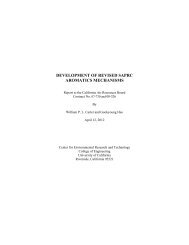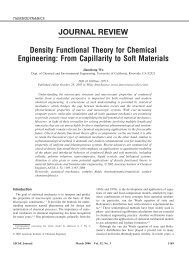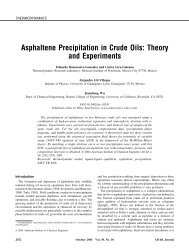Gas-Phase Ozone Oxidation of Monoterpenes: Gaseous and ...
Gas-Phase Ozone Oxidation of Monoterpenes: Gaseous and ...
Gas-Phase Ozone Oxidation of Monoterpenes: Gaseous and ...
You also want an ePaper? Increase the reach of your titles
YUMPU automatically turns print PDFs into web optimized ePapers that Google loves.
GAS-PHASE OZONE OXIDATION OF MONOTERPENES 251<br />
the experiment, one set <strong>of</strong> α i <strong>and</strong> K om,i values will not describe the SOA yields<br />
over the reaction time. The time-dependent SOA yield in the sabinene/O 3 reaction<br />
appears to be such an example (Figure 13(a)). As shown in Figure 13(a), a twoproduct<br />
model, using Equation (6) <strong>and</strong> assuming two hypothetical products with<br />
α 1 = 0.041, K om,1 = 0.154, α 2 = 0.51, <strong>and</strong> K om,2 = 0.0005, describes the<br />
time-dependent aerosol yield reasonably well up to M o ∼ 15 µg/m 3 , which corresponds<br />
to a reaction time <strong>of</strong> ∼100 min <strong>and</strong> 99% sabinene consumption. The Y(t)<br />
curve computed using Equation (6) <strong>and</strong> the α i ,<strong>and</strong>K om,i values for multiple actual<br />
products fits well the measured aerosol yields at the later stage, but represents<br />
poorly the early-stage yields. The denuder/aerosol sample was taken 232 minutes<br />
after the reaction started, therefore the measured α i ,<strong>and</strong>K om,i values <strong>of</strong> individual<br />
products reflect the SOA composition in the later stage <strong>of</strong> the experiment. The<br />
above analysis suggests that slowly forming secondary or tertiary products play<br />
a role in the aerosol formation in the sabinene/O 3 reaction. The contribution <strong>of</strong><br />
secondary products is further evidenced by the time pr<strong>of</strong>iles <strong>of</strong> sabinene mixing<br />
ratio <strong>and</strong> organic aerosol mass concentration M o . As shown in Figure 13(b),<br />
at ∼100 min, while nearly all the sabinene is reacted, the organic aerosol mass<br />
continues to grow.<br />
For reaction systems such as α-pinene/O 3 reaction, one set <strong>of</strong> α i <strong>and</strong> K om,i<br />
values is sufficient to describe the kinetics <strong>of</strong> aerosol formation. On the other h<strong>and</strong>,<br />
for reaction systems such as the sabinene/O 3 reaction, more than one set <strong>of</strong> α i <strong>and</strong><br />
K om,i values are necessary to describe the evolution <strong>of</strong> aerosol mass.<br />
6. Mechanisms <strong>of</strong> Product Formation<br />
Based on known reaction mechanisms for alkene-O 3 reactions, it is possible to<br />
propose reaction schemes to account for most <strong>of</strong> the observed products.<br />
6.1. β-PINENE/O 3 REACTION<br />
Figure 14 shows reaction sequences leading to the products in the β-pinene/O 3<br />
reaction. The reaction <strong>of</strong> β-pinene with O 3 proceeds by initial O 3 addition to the<br />
C=C bond to yield an energy-rich ozonide, which rapidly decomposes to form<br />
nopinone <strong>and</strong> a C 9 biradical. Many <strong>of</strong> the observed products are formed from the<br />
subsequent reactions <strong>of</strong> the C 9 biradical. The energy-rich C 9 biradical undergoes<br />
isomerization to give rise to two enehydroperoxides (EN 1 <strong>and</strong> EN 2 ) with excess<br />
energies. This is the so-called hydroperoxide channel. The formation <strong>of</strong> hydroxy<br />
pina ketones (P 4 ) are a result <strong>of</strong> stabilization <strong>of</strong> EN 1 <strong>and</strong> EN 2 through collision<br />
(Niki et al., 1987; Martinez <strong>and</strong> Herron, 1987, 1988; Atkinson, 1997). One additional<br />
pathway for EN 2 is to produce 3-oxo-pina ketone (P 11 )byloss<strong>of</strong>aH 2<br />
molecule. This pathway is not operative for EN 1 , because the OH group is attached<br />
to a tertiary C, <strong>and</strong> no H-atom is available for loss <strong>of</strong> a H 2 molecule. It is postulated<br />
that the energized 3-hydroxy pina ketone could undergo unimolecular dissociation
















